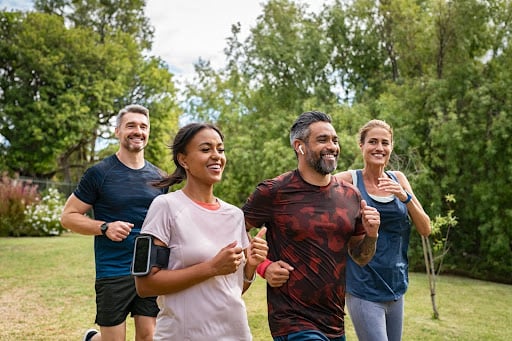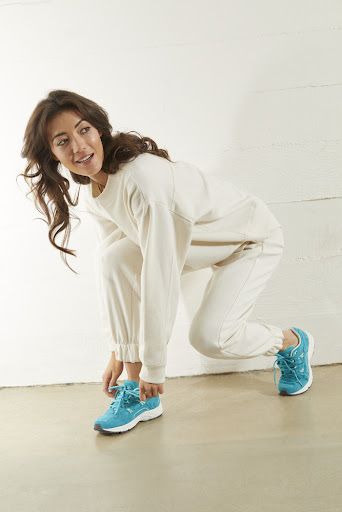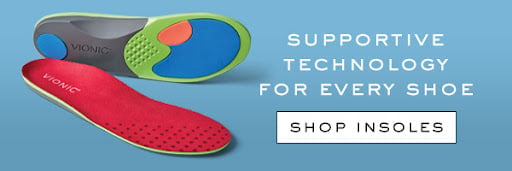The first step to achieving a high-performance workout isn’t always at the gym or on the track—it can start with lacing up your shoes. Selecting footwear you trust down every turn can set you up to be light on your feet and without footwear woes to weigh you down.
Have you felt foot pain while running? If so, one answer to how to stop foot pain when running is to choose the right pair of shoes. So, how to pick the best running shoes to help you succeed—no matter how you work out?
Whether you’re preparing for track season, training to trek a mountain, or racing to get the errands done, there’s a shoe to match your pace and prioritize your health. While there is no one-size-fits-all solution, there are some easy steps you can take to find the right fit for you.
Step 1: Know Your Foot Type
Understanding the needs of your feet and their unique shape can be the first step to optimizing your running routine. Some needs are more unique than others, such as finding the best shoes for narrow feet.
While the array of unique foot shapes don’t quite have official categories, experts in sports and medicine often group feet into three arch types.1 Arches are particularly connected to lower and upper leg movements, and each type may need specific types of support—especially when you’re working out.
Here’s a guide to help you understand your foot shape:
Low Arches
Also known as flat feet, a low arch occurs when the center of the foot barely lifts off the ground1. This type can be prone to excessive leaning inward when walking or running. Without the right support, this condition can cause footwear friction and unnatural pressure distribution leading to sores and heel pain.
If you have low arches, look for running shoes with an even cushion to help with pressure distribution and prioritize a snug heel to keep your foot in place.
Medium Arches
Those with medium arch heights have feet that appear flat when standing, but the midsole does not touch the ground.1
For feet with medium arches, consider a shoe that accommodates your foot’s length and width. Look for shoes that form to the center of your foot while allowing adequate space for your toes and heels.
High Arches
High arches, which occur when the center of the foot is visibly off the ground when standing, can result in what’s called over supination, or excessive leaning outward.1 This condition can lead to overextension or bending of the toes, and additional heel pain.
Since high arches shift pressure to the ball and heel of the foot, vigorous or high-impact exercise like running can be painful without support. You’ll want to seek out shoes that cushion your high arches and target shock absorption to help your feet withstand consistent pressure.
Step 2: Determine Your Workout Level
Whether you’re more of a speed walker or rack up the miles on your morning run, your feet still need adequate support to stay comfortable and pain-free. However, the type and intensity of your workout can signal that your shoes need certain characteristics—like more shock absorption or flexibility.
Once you’ve determined your foot shape and foot type, you’ll also want to choose an athletic shoe that works for your level of activity. Here are some options tailored to three different levels of intensity:2
- Gentle – For the occasional walk by the seashore or some simple stretching, choose a running shoe that feels light and natural on your foot to prioritize movement in your muscles and achieve low-impact mobility.
- Moderate – If you take the occasional treadmill work break or meet up with friends for a daily walk, look for flexible but supportive shoes. The goal here is to find a balance of natural mobility, lightweight fit, and cushioning for mild shock absorption.
- Vigorous – Exercise enthusiasts and athletes who plan on sprinting, distance training, or joining high-intensity games like soccer should prioritize shoes that resist wear and tear. Cushioned insoles can help prevent excessive pronation and prevent injury from overuse. If you choose a more intense workout, read more about how to prevent blisters when you’re running or doing other exercises.
Step 3: Check Your Workout Surface
Itching to venture onto that unmarked trail or shaking yourself out of bed to trudge down a familiar street for a morning jog meet-up? The type of surface you’re covering matters, too. Match your shoes to the kind of ground you plan to travel. Consider which of the below applies to your next adventure:
- Flat – If you’re trotting along a treadmill, a city sidewalk, or visiting the smooth rubber of your local track, you may not need shoes with maximum treads. Instead, lightweight shoes with lower treads should suffice in getting you from A to B, while providing some basic anti-slip support.
- Rugged – Surfaces like grassy trails, dirt roads, and trails require separate considerations. When we walk, the ball of our foot strikes first, and weight is then distributed to the outer edges of our feet—but a rugged surface with rocks, loose dirt, or grass can interrupt our natural rhythm. Shoes with larger treads can help to provide traction that helps you keep moving forward.
- Uneven – If you’d rather exchange a floor workout for a four-day backpacking venture, make sure to prioritize a new running shoe with ankle support. A shoe that laces up a little higher on the ankle can also help ensure your foot stays snug and secure, reducing friction over rocks and roots.
Step 4: Amp Up with Additional Support
When it comes to how to find the best running shoes, it’s important to remember that, considering the vast variation in foot types, there’s never just one solution. Individuals who can’t seem to find a comfortable match and seek extra support may want to consider the following:
- Orthotics – Inserts can provide additional support when your shoes aren’t enough on their own. You may want to consider these if you have especially high arches, but can’t find a pair to give your feet comfort. However, keep in mind that inserts are most often temporary fixes, and you may need to replace them over time.3
- Transition shoes – If you find you need to make a dramatic change in shoes—from elevated padding to none, for example—consider donning shoes with medium padding in the interim to adapt and train your lower muscles for impact gains.3
You should also be mindful of your foot condition. For example, if you have neutral pronation, then better wear neutral running shoes.
Tips to Help You Find Your Perfect Pair
Ready to start shopping for the right running shoe? Here’s a quick checklist to consider for the process:
- Make a list of what you need – To help you find the balance of features your feet needs, start by writing down what you plan to look for—your arch type, workout intensity, workout surface, and support needs.
- Measure your shoe size – You may feel confident about your athletic shoe size already, but if you’re investing in a new pair, it doesn’t hurt to check again. After all, feet change! In particular, as we get older, our feet can swell or change shape based on changes in circulation and overall health.4 In addition, many people find their feet to be different sizes over time.
- Try on new shoes at the end of the day – Due to circulation patterns and how our weight shifts when we stand, our feet can also swell and change slightly in size throughout the day.4 Trying on shoes when they may be tightest can help ensure you’re comfortable in any activity, at any time.
- Go for a run – If you have a chance to try the shoes on before you buy them, don’t be afraid to test them out. Zip around the store or take a quick jog up your stairwell. Your body and your feet move in different patterns when walking versus running, so make sure to test out both activities to identify your comfort level.
Running Shoes to Avoid
We’ve covered plenty of features you should look for in your running shoes—but experts also agree on a few don’ts when it comes to finding the right pair. Though these three features may seem minor, avoiding them can help you prioritize your performance and consistent mobility:3
- Extra cushion – Instead of comfort, added cushion can actually disrupt your natural running or walking patterns. Shoes with a soft bed may encourage a high-impact landing habit, leading to excessive strain on muscles, particularly in the leg and knee.
- High profile shoes – High profile refers to shoes with an increased heel insert and a lower toe drop.3 This style can cause discomfort by placing consistent pressure on the ball of the foot, which features the foot’s largest nerve network.
- Motion control – Motion control shoes are built to help prevent your feet from excessive pronation, or turning. However, the American College of Sports Medicine notes that nearly every individual exhibits some kind of inward or outward pronation.3 Shoes that restrict mobility may hinder your natural gait and encourage bad habits and posture.
In addition to these features, it’s worth considering looking into the best shoe’s for athlete’s foot to ensure you don’t catch any unwanted foot infections from shoes without proper ventilation.
Keep the Pace with Vionic
Don’t let the starting line daunt you—you shouldn’t have to be an all-star athlete to know how to choose the best running shoes. Whether you’re developing new routines or committed to fitting in a daily energy boost, nothing compares to a stride with the right footwear.
At Vionic, we’re here to help you cross the finish line—wherever it may be. Designed to follow your lead, our workout and running shoe collections let you get exactly what you need out of each workout while keeping your feet supported and comfortable.
Sprint through your days with confidence and say goodbye to discomfort with Vionic.
Sources:
- “How to determine foot arch type.” Mayo Clinic Health, 23 March, 2022. https://www.mayoclinichealthsystem.org/hometown-health/speaking-of-health/how-to-determine-foot-arch-type
- “How much physical activity do adults need?”. CDC, 2 June, 2022. https://www.cdc.gov/physicalactivity/basics/adults/index.htm
- “Selecting Running Shoes.”. American College of Sports Medicine. https://www.acsm.org/docs/default-source/files-for-resource-library/running-shoes.pdf
- “Shoes Getting Tight? Why Your Feet Change Size Over Time.” Cleveland Clinic, 19 September, 2022. https://health.clevelandclinic.org/shoes-getting-tight-feet-change-size-time/
- “Examples of Moderate and Vigorous Physical Activity.” Harvard School of Public Health. https://www.hsph.harvard.edu/obesity-prevention-source/moderate-and-vigorous-physical-activity/
- “Shoes Getting Tight? Why Your Feet Change Size Over Time.” Cleveland Clinic, 19 September, 2022. https://health.clevelandclinic.org/shoes-getting-tight-feet-change-size-time/




Leave a Reply